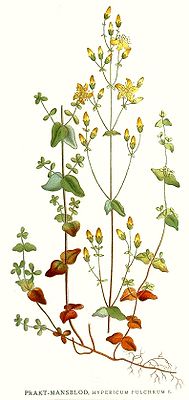Nice St. John's wort
| Nice St. John's wort | ||||||||||||
|---|---|---|---|---|---|---|---|---|---|---|---|---|

Beautiful St. John's wort ( Hypericum pulchrum ), illustration |
||||||||||||
| Systematics | ||||||||||||
|
||||||||||||
| Scientific name | ||||||||||||
| Hypericum pulchrum | ||||||||||||
| L. |
The Beautiful St. John's Wort ( Hypericum pulchrum ), also Beautiful Hartheu called, is a species of the genus of hypericum ( Hypericum ) within the family of hypericaceae (Hypericaceae).
description
Vegetative characteristics
The beautiful St. John's wort is a perennial, herbaceous plant that reaches heights of 15 to 80 centimeters. The plant parts are bare. The upright stems are round petioles. The opposite constantly seated on the stems leaves with a length of 0.5 to 2 centimeters wide-triangular heart-shaped at the bottom and there blunt at breitesten and end. They are dotted with translucent glands, the leaf margin is without black glands.
Generative characteristics
It blooms from July to September. The flowers are arranged in a loose panicle inflorescence . The hermaphroditic flowers have a double flower envelope . The sepals are 2 to 3 millimeters long and ovate, blunt and dotted with black glands on the edge. The free, golden-yellow, often reddish-colored petals are 6 to 9 millimeters long. The many stamens are grouped into bundles.
The number of chromosomes is 2n = 18.
ecology
The beautiful St. John's wort is an evergreen Chamaephyte . Vegetative reproduction occurs through underground runners . The leaves are discolored by anthocyanins , which serve as light protection, dark red.
The wall-gap capsule fruits act as wind and animal spreaders.
Occurrence
The distribution area extends from north-west and west Europe to north-west Croatia . In New Zealand, Hypericum pulchrum is a neophyte .
The beautiful St. John's wort occurs scattered in deciduous and mixed forests and in coniferous forests. It thrives best in clearings or on the edges of forests on acidic sand or clay soils . This plant species is lime-shy and therefore indicates the decalcification of the soil surface. It thrives in plant communities of the Quercion roboris association, but also occurs in those of the Luzulo-Fagenion or Sarothamnenion sub-associations.
Taxonomy
Hypericum pulchrum was first published in 1753 by Carl von Linné in Species Plantarum , p. 786. Synonyms for Hypericum pulchrum L. are: Hypericum amplexicaule Gilib. , Hypericum pulchrum var. Procumbens (Rostr.) Beeby , Hypericum pulchrum var. Gillotii Rouy , Hypericum pulchrum var. Pallidum Rouy . Subtaxa are not accepted.
Ingredients and effects
The beautiful St. John's wort contains the red dye hypericin in the flowers , which can cause light sickness in animals . Because of the red hypericin and its wound-healing properties , St. John's wort is also called Jesus' wort .
literature
- Dietmar Aichele: What is blooming there? The photo book. 5th edition, Kosmos, Stuttgart, 2004, 446 pages, ISBN 3-440-10281-5 .
- Ruprecht Düll , Herfried Kutzelnigg : Pocket dictionary of plants in Germany and neighboring countries. The most common Central European species in portrait. 7th, corrected and enlarged edition. Quelle & Meyer, Wiebelsheim 2011, ISBN 978-3-494-01424-1 .
Individual evidence
- ↑ a b Erich Oberdorfer : Plant-sociological excursion flora for Germany and neighboring areas. 8th edition. Verlag Eugen Ulmer, Stuttgart 2001, ISBN 3-8001-3131-5 . Page 664–665.
- ↑ a b Rafaël Govaerts (Ed.): Hypericum pulchrum - World Checklist of Selected Plant Families of the Royal Botanic Gardens, Kew. Last accessed on May 14, 2017.
Web links
- Nice St. John's wort . In: BiolFlor, the database of biological-ecological characteristics of the flora of Germany.
- Hypericum pulchrum L., Nice hard hay. In: FloraWeb.de.
- Profile and distribution map for Bavaria . In: Botanical Information Hub of Bavaria .
- Hypericum pulchrum L. In: Info Flora , the national data and information center for Swiss flora .
- Distribution in the northern hemisphere according to Eric Hultén .
- Thomas Meyer: Data sheet with identification key and photos at Flora-de: Flora von Deutschland (old name of the website: Flowers in Swabia ).
- Beautiful St. John's wort as a poisonous plant at giftpflanze.com .


